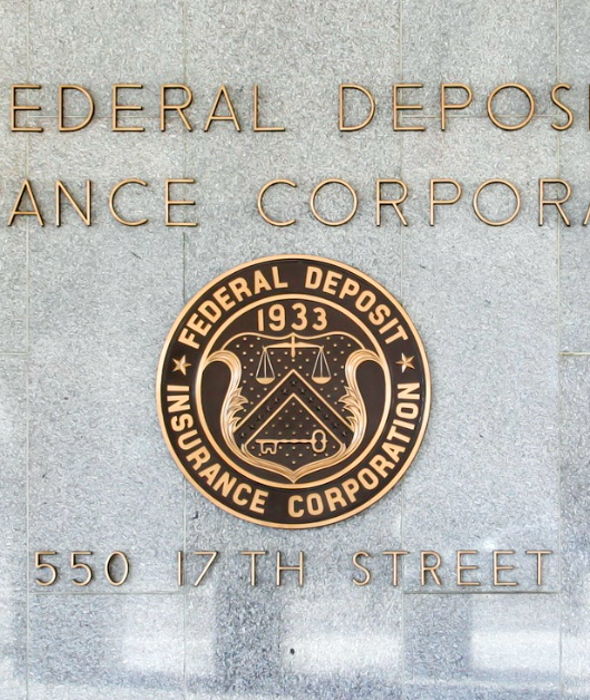
Share this Post
Subscribe

Need help with your money or investments? Book a consultation to learn more about working together.
FDIC Insurance Limits Explained – How Much Coverage Do You Have?
[Prefer to listen? You can find a podcast version of this article here: E178: FDIC Insurance Limits Explained – How Much Coverage Do You Have?]
FDIC insurance has been around for a long time. We see the FDIC logos on our bank’s website and on the lobby door (for those who occasionally find themselves in a branch). But how much do you know about how FDIC insurance works? How does it protect you? What are its limits?
FDIC insurance is a financial safety net that's more important than you might think. Born during the Great Depression, FDIC insurance has been protecting our hard-earned money from bank failures for decades.
Any time there are bank failures in the news, FDIC insurance becomes a topic of interest as many folks get concerned about their money.
Let’s take a closer look at how it works, its coverage limits, and tips to make the most out of the protection it offers.
What is FDIC insurance?
FDIC insurance, provided by the Federal Deposit Insurance Corporation (FDIC), is a government-backed program designed to protect depositors' funds held in banks and savings institutions in the event of a bank failure. Established in 1933 as a response to the widespread bank failures during the Great Depression, FDIC insurance has played a vital role in maintaining public confidence in the United States banking system.
The FDIC is an independent federal agency, and its primary purpose is to maintain stability and public trust in the financial system by insuring deposits, supervising financial institutions for safety and soundness, and managing receiverships in case a bank fails.
How much coverage do you have?
FDIC insurance covers various types of deposit accounts, including checking accounts, savings accounts, money market deposit accounts, and certificates of deposit (CDs). Certain retirement accounts, such as individual retirement accounts (IRAs) and self-directed 401(k) plans, are also insured by the FDIC. However, it is essential to note that investments in stocks, bonds, mutual funds, and annuities are not covered by FDIC insurance.
The standard FDIC insurance limit is $250,000 per depositor, per insured bank, for each account ownership category. This means that an individual can have multiple accounts insured up to $250,000 each at the same bank, provided they are in different ownership categories, such as individual accounts, joint accounts, or trust accounts.
For example, if a depositor has a savings account, a checking account, and a joint account with a spouse at the same bank, each account is insured separately:
- Individual savings account: $250,000 coverage
- Individual checking account: $250,000 coverage
- Joint account with spouse: $500,000 coverage ($250,000 for each account holder)
In this example, the depositor (each individual person) would have a total FDIC insurance coverage of $750,000 at the same bank, across different account types and ownership categories.
It's also worth noting that custodian accounts (e.g., UTMA or UGMA) in a minor's name count as separate ownership types. For FDIC coverage purposes, the insurance treats this as an account held by the child.
The FDIC website also has a handy Electronic Deposit Insurance Estimator (EDIE) that can help you calculate your FDIC coverage in your accounts.
What types of accounts are covered?
FDIC insurance covers various types of deposit accounts, ensuring that depositors' funds are protected in case of a bank failure. The following account types are covered by FDIC insurance:
- Checking accounts: These accounts are used for everyday transactions, such as paying bills and making purchases. They usually come with check-writing privileges and a debit card for easy access to funds.
- Savings accounts: These accounts are designed to help individuals save money over time. They usually offer a modest interest rate and may have restrictions on the number of withdrawals allowed per month.
- Money market deposit accounts (MMDAs): These accounts are a hybrid between checking and savings accounts, offering a higher interest rate than traditional savings accounts while still allowing for limited check-writing privileges and debit card access.
- Certificates of deposit (CDs): CDs are time deposits that require depositors to keep their money in the account for a predetermined period, ranging from a few months to several years. In return, they typically offer higher interest rates compared to other deposit accounts.
- Negotiable order of withdrawal (NOW) accounts: These interest-bearing accounts are similar to checking accounts, allowing depositors to write checks and access their funds easily. However, they usually require a minimum balance to earn interest.
- Individual Retirement Arrangements (IRAs): FDIC insurance covers traditional IRAs, Roth IRAs, Simplified Employee Pension (SEP) IRAs, and Savings Incentive Match Plan for Employees (SIMPLE) IRAs, but only for the cash deposits held in these accounts, not for the investments in stocks, bonds, or mutual funds.
- Self-directed 401(k) plans: FDIC insurance covers the cash deposits held in these retirement accounts as well, but not any investments in stocks, bonds, or mutual funds.
- Revocable trust accounts: A revocable trust account is a financial account held by a revocable trust, allowing the grantor to manage and control the assets within the trust while maintaining the option to modify or dissolve the trust during their lifetime.
- Irrevocable trust accounts: An irrevocable trust account is a financial account held by an irrevocable trust, containing assets that have been permanently transferred to the trust, with the grantor unable to modify or dissolve the trust after its creation.
Note that FDIC insurance does not cover investments such as stocks, bonds, mutual funds, or annuities, even if they are purchased at an FDIC-insured bank or savings institution. Additionally, safe deposit boxes or their contents are not covered by FDIC insurance.
Do banks ever offer more coverage than the default FDIC limits?
Some banks enhance FDIC coverage through IntraFi.
IntraFi Network (formerly known as Promontory Interfinancial Network) is a company that offers financial institutions a suite of services, one of which is IntraFi Network Deposits (previously known as CDARS and ICS). IntraFi Network Deposits allows banks to provide their customers with access to FDIC insurance coverage beyond the standard $250,000 limit by placing customer funds into deposit accounts at other participating banks within the IntraFi Network.
When a customer deposits a large sum of money that exceeds the FDIC insurance limit at a single bank, the bank uses IntraFi Network Deposits to distribute the customer's funds into smaller amounts across multiple participating banks, ensuring that each portion is within the FDIC insurance coverage limit. This way, the customer's entire deposit remains fully FDIC-insured, even though it is spread across several banks. IntraFi Network Deposits simplifies the process for customers and banks, making it easier to maintain FDIC insurance for large deposits without requiring the customer to manage multiple accounts at different banks.
Not all banks participate in IntraFi Network Deposits to extend additional FDIC coverage. IntraFi is a voluntary service, and it is up to each financial institution to decide whether or not to participate in the program.
If you are interested in utilizing IntraFi Network Deposits, it's essential to ask your bank whether they participate in the program or not.
What happens if your bank fails?
If your bank fails, FDIC insurance is designed to protect your deposits up to the coverage limit. The FDIC will typically step in and either transfer your deposits to another insured bank or provide you with a check for the insured amount.
It's important to note that not all types of accounts are covered by FDIC insurance, such as investments in stocks, bonds, or mutual funds. It's also essential to keep your account information up to date with your bank to ensure that the FDIC can contact you in the event of a bank failure.
Has the FDIC ever defaulted during a bank failure?
Since its establishment in 1933, the FDIC has never defaulted on its insurance obligations during a bank failure.
The FDIC is backed by the full faith and credit of the United States government, which ensures the reliability of its deposit insurance system. Throughout its history, the FDIC has successfully managed numerous bank failures and protected depositors' insured funds, maintaining the confidence of the public in the U.S. banking system.
How to maximize your FDIC insurance coverage
To maximize your FDIC insurance coverage, it's important to understand the limits and how they apply to your accounts.
The standard coverage limit is $250,000 per depositor, per insured bank, for each account ownership category. This means that if you have multiple accounts at the same bank, such as a checking account and a savings account, they may be covered separately up to the limit for each ownership category.
You can also increase your coverage by opening accounts at different banks or by using different ownership categories, such as joint accounts or trust accounts.
It's important to regularly review your accounts and make sure they are fully covered by FDIC insurance.

